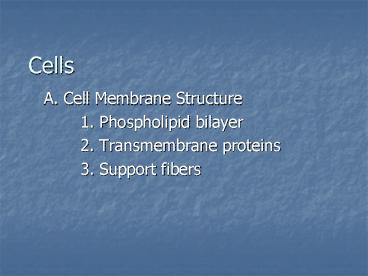Cells - PowerPoint PPT Presentation
1 / 22
Title:
Cells
Description:
A. Cell Membrane Structure. 1. Phospholipid bilayer. 2. Transmembrane proteins ... Cell Membranes ... and move around in membrane (ex. Mouse/human cell expt. ... – PowerPoint PPT presentation
Number of Views:234
Avg rating:3.0/5.0
Title: Cells
1
Cells
- A. Cell Membrane Structure
- 1. Phospholipid bilayer
- 2. Transmembrane proteins
- 3. Support fibers
2
Cells/ Cell Membranes
- 1. Phospholipid bilayer
- glycerol with two fatty acid chains alcohol
bonded with phosphate - F.A. chains are hydrophobic/ alcohol and
phosphate end hydrophilic - Phospholipids are amphipathic (hydrophilic and
hydrophobic ends on the same molecule)
3
Cells/ Cell Membranes/phospholipids
- Since water is present inside and outside of
cells, phospholipids must exist in a bilayer
arrangement. - Hydrophilic ends toward the surfaces/ hydrophobic
ends toward the middle
4
Cells/ Cell Membranes/phospholipids
5
Cells/ Cell Membranes
- 2. Transmembrane proteins
- Held in membrane with hydrophilic/hydrophobic
interactions - Many can float and move around in membrane (ex.
Mouse/human cell expt.) - Serve a variety of functions in the membrane
- a. transport c. receptors e. adhesion
- b. enzymes d. cytoskeleton f. identity
6
Cells/ Cell Membranes/Transmembrane proteins
- a. Transport
- proteins that transect the membrane and serve as
channels to allow specific molecules to
enter/leave the cell - b. Enzymes
- proteins that are bound to membrane and project
inward in order to catalyze cell reactions
7
Cells/ Cell Membranes/Transmembrane proteins
- c. Receptor proteins
- proteins transecting membrane that have receptor
sites on outside of membrane. When a hormone
binds with the receptor site, the protein causes
the cell to change its activities.
8
Cells/ Cell Membranes/Transmembrane proteins
- d. Cytoskeleton
- certain membrane proteins exist to bind to the
cytoskeleton as an attachment point so the cell
can take on a particular shape. - e. Adhesion
- some proteins exist to adhere to a neighboring
cells adhesion proteins to form a temporary or
permanent bond with the neighboring cell.
(desmosome)
9
Cells/ Cell Membranes/Transmembrane proteins
- f. Cell identity
- glycoproteins (carboh. protein) exist in the
cell membrane to identify the cell as self.
(used in cell recognition for immune system) - glycolipids (carboh. lipid) exist in the
membrane to identify tissue type (ABO blood group)
10
Cells/ Cell Membranes
- 3. Support fibers
- some fibers pull on cytoskeleton proteins in the
membrane to hold a cell in a particular shape
(e.g. red blood cells.) - some fibers anchor proteins so they dont float
around too much in the membrane (e.g. channel
proteins on the surface of a membrane)
11
Cells/ Cell Membranes
- B. Movement of materials across membranes
- 1. Diffusion
- 2. Osmosis
- 3. Facilitated diffusion
- 4. Endocytosis/Exocytosis
- 5. Active transport
12
Cells/ Cell Membranes/ Movement of materials
across membranes
- 1. Diffusion definition-
- mvmnt of matl from areas of greater conc. to
areas of lesser conc. - Factors affecting diffusion rate
- temperature
- Concentration gradient
- Size of molecules
- Phase of material in which diff. is occurring
13
Cells/ Cell Membranes/ Movement of materials
across membranes
- 2. Osmosis definition
- movement of water/solvent across membranes from
an area of high conc. to an area of lower conc. - Factors affecting osmosis rate
- -Temp. -conc. Gradient
- -size of molecules - size of membrane pores
- - -
14
Cells/ Cell Membranes/ Movement of materials
across membranes
- 3. Facilitated diffusion definition
- movement of substances across cell membranes
using a carrier molecule from an area of high
conc. to an area of lower conc.
15
Cells/ Cell Membranes
- Endocytosis/ Exocytosis
- Endocytosis is taking in of large amounts of
materials or large particles/cells by surrounding
with a part of the cell membrane
16
Cells/ Cell Membranes/Endocytosis
17
Cells/ Cell Membranes/ Movement of materials
across membranes
- 5. Active transport
- mvmnt of materials across cell memb. against a
concentration gradient (low -gt high) requiring
use of the cells energy reserves. - Ex. Proton pump
- Sodium/potassium pump
18
Cells/ Cell Membranes/ Movement of materials
across membranes
- Proton pump
- Carrier protein on membrane of cell has active
site for H. - When H binds to protein, an ATP is used to
change the shape of the protein moving H to the
outside of the cell. - This is a very old mechanism seen in
prokaryotes and eukaryotes.
19
Cells/ Cell Membranes/ Movement of materials
across membranes
- Sodium-Potassium pump
- Carrier protein in cell membrane has binding
sites for Na and K but NOT AT THE SAME TIME. - 3 Na bind to the Na active site, and ATP is
used to move them to the outside of the cell and
P is attached to carrier protein. Once Na is
released, protein changes its shape to open K
binding sites. Two K bind to sites and protein
changes shape back to move K to cytoplasm.
Phosphate is released from protein.
20
Cells/ Cell Membranes/ Movement of materials
across membranes
21
Cells/ Cell Membranes/ Movement of materials
across membranes
- Why move protons and/or Na against conc.
gradient? - This is stored energy!
- Coupled channels
- cotransport
- countertransport
22
Cells/ Cell Membranes/ Movement of materials
across membranes































